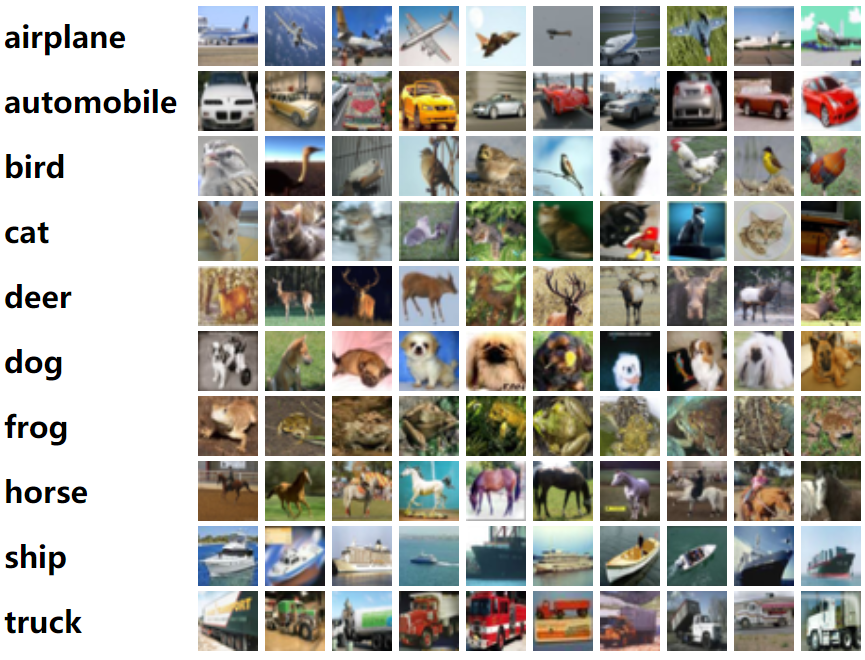深度残差收缩网络其实是一种通用的特征学习方法,是深度残差网络ResNet、注意力机制和软阈值化的集成,可以用于图像分类。本文采用TensorFlow 1.0和TFLearn 0.3.2,编写了图像分类的程序,采用的图像数据为CIFAR-10。CIFAR-10是一个非常常用的图像数据集,包含10个类别的图像。可以在这个网址找到具体介绍:https://www.cs.toronto.edu/~kriz/cifar.html

参照ResNet代码(https://github.com/tflearn/tflearn/blob/master/examples/images/residual_network_cifar10.py),所编写的深度残差收缩网络的代码如下:
#!/usr/bin/env python3
# -*- coding: utf-8 -*-
"""
Created on Mon Dec 23 21:23:09 2019
M. Zhao, S. Zhong, X. Fu, B. Tang, M. Pecht, Deep Residual Shrinkage Networks for Fault Diagnosis,
IEEE Transactions on Industrial Informatics, 2019, DOI: 10.1109/TII.2019.2943898
@author: super_9527
"""
from __future__ import division, print_function, absolute_import
import tflearn
import numpy as np
import tensorflow as tf
from tflearn.layers.conv import conv_2d
# Data loading
from tflearn.datasets import cifar10
(X, Y), (testX, testY) = cifar10.load_data()
# Add noise
X = X + np.random.random((50000, 32, 32, 3))*0.1
testX = testX + np.random.random((10000, 32, 32, 3))*0.1
# Transform labels to one-hot format
Y = tflearn.data_utils.to_categorical(Y,10)
testY = tflearn.data_utils.to_categorical(testY,10)
def residual_shrinkage_block(incoming, nb_blocks, out_channels, downsample=False,
downsample_strides=2, activation='relu', batch_norm=True,
bias=True, weights_init='variance_scaling',
bias_init='zeros', regularizer='L2', weight_decay=0.0001,
trainable=True, restore=True, reuse=False, scope=None,
name="ResidualBlock"):
# residual shrinkage blocks with channel-wise thresholds
residual = incoming
in_channels = incoming.get_shape().as_list()[-1]
# Variable Scope fix for older TF
try:
vscope = tf.variable_scope(scope, default_name=name, values=[incoming],
reuse=reuse)
except Exception:
vscope = tf.variable_op_scope([incoming], scope, name, reuse=reuse)
with vscope as scope:
name = scope.name #TODO
for i in range(nb_blocks):
identity = residual
if not downsample:
downsample_strides = 1
if batch_norm:
residual = tflearn.batch_normalization(residual)
residual = tflearn.activation(residual, activation)
residual = conv_2d(residual, out_channels, 3,
downsample_strides, 'same', 'linear',
bias, weights_init, bias_init,
regularizer, weight_decay, trainable,
restore)
if batch_norm:
residual = tflearn.batch_normalization(residual)
residual = tflearn.activation(residual, activation)
residual = conv_2d(residual, out_channels, 3, 1, 'same',
'linear', bias, weights_init,
bias_init, regularizer, weight_decay,
trainable, restore)
# get thresholds and apply thresholding
abs_mean = tf.reduce_mean(tf.reduce_mean(tf.abs(residual),axis=2,keep_dims=True),axis=1,keep_dims=True)
scales = tflearn.fully_connected(abs_mean, out_channels//4, activation='linear',regularizer='L2',weight_decay=0.0001,weights_init='variance_scaling')
scales = tflearn.batch_normalization(scales)
scales = tflearn.activation(scales, 'relu')
scales = tflearn.fully_connected(scales, out_channels, activation='linear',regularizer='L2',weight_decay=0.0001,weights_init='variance_scaling')
scales = tf.expand_dims(tf.expand_dims(scales,axis=1),axis=1)
thres = tf.multiply(abs_mean,tflearn.activations.sigmoid(scales))
# soft thresholding
residual = tf.multiply(tf.sign(residual), tf.maximum(tf.abs(residual)-thres,0))
# Downsampling
if downsample_strides > 1:
identity = tflearn.avg_pool_2d(identity, 1,
downsample_strides)
# Projection to new dimension
if in_channels != out_channels:
if (out_channels - in_channels) % 2 == 0:
ch = (out_channels - in_channels)//2
identity = tf.pad(identity,
[[0, 0], [0, 0], [0, 0], [ch, ch]])
else:
ch = (out_channels - in_channels)//2
identity = tf.pad(identity,
[[0, 0], [0, 0], [0, 0], [ch, ch+1]])
in_channels = out_channels
residual = residual + identity
return residual
# Real-time data preprocessing
img_prep = tflearn.ImagePreprocessing()
img_prep.add_featurewise_zero_center(per_channel=True)
# Real-time data augmentation
img_aug = tflearn.ImageAugmentation()
img_aug.add_random_flip_leftright()
img_aug.add_random_crop([32, 32], padding=4)
# Building Deep Residual Shrinkage Network
net = tflearn.input_data(shape=[None, 32, 32, 3],
data_preprocessing=img_prep,
data_augmentation=img_aug)
net = tflearn.conv_2d(net, 16, 3, regularizer='L2', weight_decay=0.0001)
net = residual_shrinkage_block(net, 1, 16)
net = residual_shrinkage_block(net, 1, 32, downsample=True)
net = residual_shrinkage_block(net, 1, 32, downsample=True)
net = tflearn.batch_normalization(net)
net = tflearn.activation(net, 'relu')
net = tflearn.global_avg_pool(net)
# Regression
net = tflearn.fully_connected(net, 10, activation='softmax')
mom = tflearn.Momentum(0.1, lr_decay=0.1, decay_step=20000, staircase=True)
net = tflearn.regression(net, optimizer=mom, loss='categorical_crossentropy')
# Training
model = tflearn.DNN(net, checkpoint_path='model_cifar10',
max_checkpoints=10, tensorboard_verbose=0,
clip_gradients=0.)
model.fit(X, Y, n_epoch=100, snapshot_epoch=False, snapshot_step=500,
show_metric=True, batch_size=100, shuffle=True, run_id='model_cifar10')
training_acc = model.evaluate(X, Y)[0]
validation_acc = model.evaluate(testX, testY)[0]
上面的代码构建了一个小型的深度残差收缩网络,只含有3个基本残差收缩模块,其他的超参数也未进行优化。如果为了追求更高的准确率的话,可以适当增加深度,增加训练迭代次数,以及适当调整超参数。
前五篇的内容:
深度残差收缩网络:(一)背景知识 https://www.cnblogs.com/yc-9527/p/11598844.html
深度残差收缩网络:(二)整体思路 https://www.cnblogs.com/yc-9527/p/11601322.html
深度残差收缩网络:(三)网络结构 https://www.cnblogs.com/yc-9527/p/11603320.html
深度残差收缩网络:(四)注意力机制下的阈值设置 https://www.cnblogs.com/yc-9527/p/11604082.html
深度残差收缩网络:(五)实验验证 https://www.cnblogs.com/yc-9527/p/11610073.html
原文的链接:
M. Zhao, S. Zhong, X. Fu, B. Tang, and M. Pecht, “Deep Residual Shrinkage Networks for Fault Diagnosis,” IEEE Transactions on Industrial Informatics, 2019, DOI: 10.1109/TII.2019.2943898





